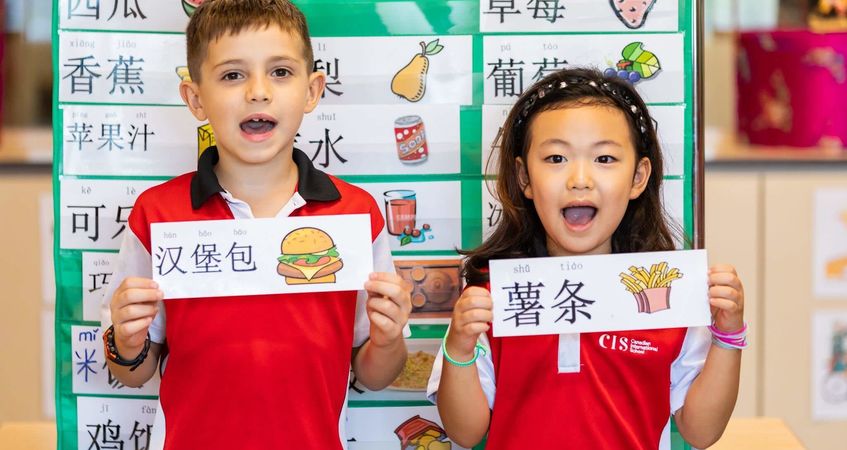International schools in Singapore offer some very robust bilingual programmes that address the demand for quality bilingual education, catering to children from the kindergarten to high school levels. Equipping children with competencies in various world languages like Chinese, French, or Spanish, these programmes aim to help children reap the benefits of being a bilingual speaker.
The Canadian International School (CIS) is one school with such programmes. Its Chinese-English bilingual programme and French-English bilingual programme are dedicated education pathways for children to develop competencies in their chosen language pair. Its established track record of producing fluent bilingual communicators has pitched CIS as a highly desirable school for early bilingual education.
The CIS Strategy to Bilingual Education
Taking the CIS Chinese-English bilingual programme as a case study, one can take a glimpse into how CIS maintains its position as one of the nation’s top bilingual programmes in an international school.
CIS’s Chinese-English bilingual programme is built based on an immersion framework. The medium of instruction alternates between English and Chinese across the days of the week, ensuring that children are given equal exposure to both languages throughout their time in the programme. This also means that children learn all subjects in both languages, giving children a vast knowledge base in both English and Chinese.
Every class is helmed by two teachers: one native English speaker and one native Chinese speaker. What results is a fully immersive learning experience. Coupled with inquiry-based instruction and engaging learning activities through songs and stories, language learning is made to feel effortless and exciting for children in the programme.
Fun and games aside, the Chinese-English bilingual programme is also fully aligned with the International Baccalaureate (IB) Primary Years Programme (PYP) in Singapore. Starting at the junior kindergarten level, the programme gears children towards taking the Youth Chinese Test up till they complete the syllabus in Grade 6.
Year on year, CIS’ Chinese-English bilingual programme has emerged with commendable results in the Youth Chinese Test. Even students who enter with minimal prior knowledge of the Chinese language have been witnessed to follow through the lessons effectively after a short while, and most students are able to communicate confidently in Chinese without relying on pinyin after a few years in the programme.
Why Choose CIS’ Chinese-English Bilingual Programme?
Besides being known for their stellar track record in bilingual education, CIS’ Chinese-English Bilingual Programme is also well-received by parents who wish to give their children a headstart in life.
Most researchers in the field of bilingualism agree that childhood is the best time for picking up new languages. Not only does early bilingual education make it more likely for children to achieve fluency, but it also results in more pronounced benefits for them in the long run. When you enrol your child in a robust bilingual programme like CIS’ Chinese-English Bilingual Programme, your child stands to enjoy even more benefits from the well-crafted programme. Here are some of them:
1. Cognitive benefits
Cognitively, bilinguals have been found to be better task-switchers, making them more efficient workers and thinkers. Due to their constant need to grapple with the ambiguities of two languages, bilinguals also frequently turn out to be more flexible thinkers, giving them an edge when it comes to solving complex or abstract problems. From the practice of learning two languages from a young age, bilinguals also become more adept at language learning, giving them an advantage for picking up new languages even later in life.
2. Learn from native speakers
In CIS’ Chinese-English bilingual programme, students are given the invaluable opportunity to learn from native speakers. Apart from affirming the quality of language input from the teachers, this also allows students to achieve native-like fluency more easily, especially when it comes to accent and pronunciation.
3. Well-paced learning
Through an inquiry-based learning approach, children can learn at their own pace in a safe and nurturing environment without the added pressure of heavily weighted tests and deadlines. At this age, children are also more game for trying out new things, which will help them in practising and gaining competency in their languages.
4. Exposure to other cultures
Language is not the only thing children at the Chinese-English bilingual programme will learn. Alongside language, the programme exposes them to Chinese culture as well. This expands the students’ world views and develops their sensitivity and awareness of other cultures.
5. Resources at your fingertips
Students of CIS’s Chinese-English bilingual programme stand to enjoy learning through 130 storybooks from the Big Apple Programme, on top of over 8000 Chinese fiction books available in the school’s collection. The wealth of resources makes reading readily accessible to all students in the programme, promoting literacy and enjoyment for reading.
Choosing A Bilingual Programme in Singapore
CIS’s Chinese-English bilingual programme is only one out of many amongst international schools in Singapore, but also arguably one of the best you can find that is also aligned towards the IB education. The school also hosts a French-English bilingual programme that is highly regarded.
If you are in the market for a bilingual programme for your child, do consider the framework used by the school for imparting bilingual competency, and evaluate the benefits their programme will have for your child. Academic track records are also a helpful indicator when it comes to selecting the best bilingual programme.
The popularity of bilingual programmes seems to be holding up as the world increasingly recognises the advantages of being bilingual. Let your child reap these benefits by giving them the gift of bilingual education.




